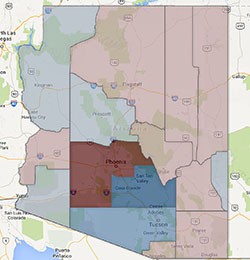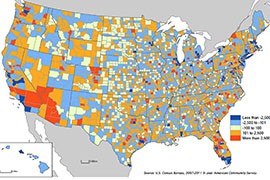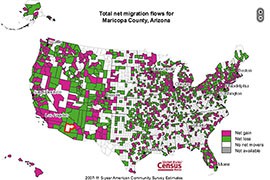Cronkite News has moved to a new home at cronkitenews.azpbs.org. Use this site to search archives from 2011 to May 2015. You can search the new site for current stories.
Maricopa got residents from across U.S., lost them to nearby counties
WASHINGTON – Maricopa County gained residents from nearly 1,000 counties across the U.S. – from Pinal County to as far away as Washington County, Maine – and lost residents to an even wider swath, the Census Bureau reported.
But within Arizona, Maricopa saw a net loss of population to other counties, while Pinal and Pima had net gains of in-state residents between 2007 to 2011, the latest years for which numbers are available.
Experts said the shifts could be driven by anything from the movement of retirees or college students to a search for jobs or affordable housing. They also noted that the report released last week, “2007-2011 County-to-County Migration Flows,” covers a period that included much of the recession.
“Job growth is typically one important factor that will drive migration flows,” said George Hammond, an economist and professor at the Eller College of Management at the University of Arizona.
He said the economic downturn had a different effect on Phoenix and Tucson, which could be surfacing in the migration numbers. During the economic downturn, Phoenix had a peak-to-trough job loss of 13 percent while Tucson had a job loss of 9 percent.
That was echoed by Tom Rex of Arizona State University’s W.P. Carey School of Business, who said migration flows are very much tied to economic factors.
Rex noted that the years in the latest Census data include the recession. That had a large impact on Arizona and specifically on Maricopa County – although he called migration out of Maricopa quite small given the county’s overall size.
According to the data, most counties in Arizona had net migration gains from U.S. counties and in some cases from abroad from 2007 to 2011.
The biggest overall gainers in the state were Maricopa, Pima, Pinal, Mohave and Yavapai counties. Pinal had the largest net gain, with 17,034 more residents, followed by Pima with 9,457, according to the data. Maricopa County, which accounts for about 60 percent of Arizona’s population, was third with a net gain of 7,781 residents.
Within the state – Arizonans moving from one county to another – Maricopa was the biggest loser, seeing more than 10,000 residents move to other counties. Pinal, on the other hand, gained more than 7,000.
Some moves, such as Maricopa to Pinal, may simply have been people keeping their jobs but moving to a new county, Rex said. Others, such as a Maricopa-to-Yavapai move, may be retirees who want to get away from the metro area or escape the heat.
“What you have happening in Pima County, it’s probably a lot of college-age students,” Rex said. Because the University of Arizona is large compared to Pima County’s population, the students who move there have a larger net effect than ASU would have on Maricopa County, he said.
The recession may have also affected Flagstaff, but in a different way, said Northern Arizona University’s Thomas Combrink.
“When times are tough, it’s more expensive to live up here, so people head south,” said Combrink, a senior research specialist at the Alliance Bank Business Outreach Center at the W.A. Franke College of Business.
He added that Flagstaff doesn’t benefit as much from retiree migration due to its altitude, which “some older folks don’t like.”
Combrink called Pinal a “strange county” because of its enormous growth over the last decade.
“Pinal County has one advantage: It has cheap land,” he said, noting the county has large housing developments along its Pima and Maricopa county borders.
Jim Chang, state demographer for the Arizona Office of Employment and Population Statistics, agreed that most migration into Pinal County had to do with low housing prices there after the economic downturn.
But Chang warned against trying to extrapolate current trends from the 2007-2011 data. Any year, it can be a balance between the cost of housing and the time of commute for people who might consider relocating to Pinal County, he said.









